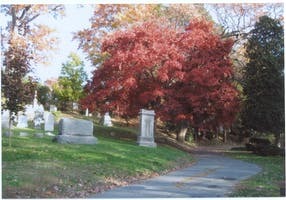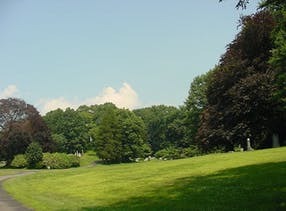

History
Springfield Cemetery - 177 Years of History
Massachusetts is rich in historic sites: Old Deerfield, Old Sturbridge Village, Plimouth Plantation, the Springfield Armory. The Springfield Cemetery is one of these locations of historical interest. Cemeteries, rich in lore, and containing the remains of historically significant people, also represent the development of American landscape gardening and design, monumental architecture, and natural history, reflecting, in some cases, 300 years of American social and cultural evolution.There are about 14 generations of New Englanders buried in Springfield Cemetery, forming part of national history going back into the sixteen hundreds. Springfield Cemetery is a rural cemetery that highlights both history and natural beauty. There are over a million plantings in the Cemetery that create a natural appeal of beauty and serenity.
Massachusetts is rich in historic sites: Old Deerfield, Old Sturbridge Village, Plimouth Plantation, the Springfield Armory. The Springfield Cemetery is one of these locations of historical interest. Cemeteries, rich in lore, and containing the remains of historically significant people, also represent the development of American landscape gardening and design, monumental architecture, and natural history, reflecting, in some cases, 300 years of American social and cultural evolution.There are about 14 generations of New Englanders buried in Springfield Cemetery, forming part of national history going back into the sixteen hundreds. Springfield Cemetery is a rural cemetery that highlights both history and natural beauty. There are over a million plantings in the Cemetery that create a natural appeal of beauty and serenity.
Historical Highlights
Mount Auburn, which opened in Cambridge, Massachusetts in 1831 was the first landscaped American Cemetery. Springfield soon followed Mount Auburn's lead and opened in 1841. Garden cemeteries, such as Springfield Cemetery, are called "rural cemeteries" even though most are in or near urban centers, but of their carefully designed park-like landscapes of rolling hills; valleys; willow, cypress, and pine stands; and exotic paintings; winding paths; and well-sited, appropriately and artifically aged-looking Gothic or Egyptian architecture - all providing an atmosphere of peace, contemplation, and order.
Mount Auburn, which opened in Cambridge, Massachusetts in 1831 was the first landscaped American Cemetery. Springfield soon followed Mount Auburn's lead and opened in 1841. Garden cemeteries, such as Springfield Cemetery, are called "rural cemeteries" even though most are in or near urban centers, but of their carefully designed park-like landscapes of rolling hills; valleys; willow, cypress, and pine stands; and exotic paintings; winding paths; and well-sited, appropriately and artifically aged-looking Gothic or Egyptian architecture - all providing an atmosphere of peace, contemplation, and order.

The site for Springfield Cemetery was originally known as Martha's Dingle, a site of hills, ravines, brooks, and a natural bird sanctuary. The dingle had once been owned by Martha Ferre. Martha sold the land to Alexander Bliss, a local businessman to raise a dowry. On May 28, 1841 the founding member of Springfield Cemetery purchased the 20 acres of land from Alexander Bliss, or the site known as Martha's Dingle.

In March 1845 the proprietors of Springfield Cemetery voted to build a gateway, designed by William B. O. Peabody, Unitarian minister and founding member, at the Maple Street entrance, the present main entrance, known as Cemetery Lane. It was to symbolize the division between the "city of the living" and the "city of the dead". According to the burial custom of the day, pall bearers carried casket
